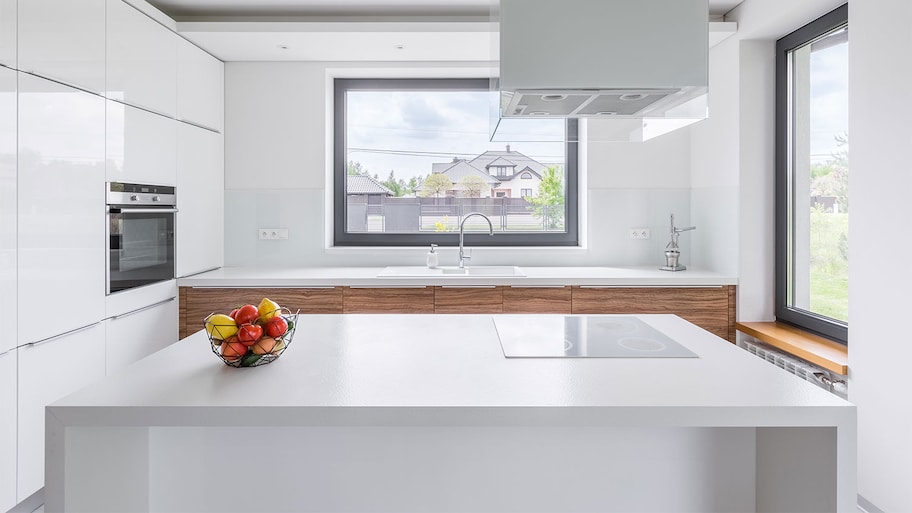From eased edges to rustic custom cuts, countertop edges can perfect your kitchen’s style
Updating a kitchen with new countertops means making lots of design choices. In addition to the basic material, style, and color, you also need to be aware of the kind of edges you want for your kitchen countertops. Learn more about the eight most common countertop edges and their design styles.
1. Eased Edges

If your kitchen is small, or oddly configured with tight walking spaces, consider the eased edge. With the slight curve to the corners and flat sides, eased counter edges work especially well with restrictive kitchen spaces. Another plus for eased countertop edges is that their cost is relatively reasonable and the clean, smooth profile works well with a wide variety of designs, from contemporary to more traditional.
2. Square Edges

If the understated design profile of the eased edge appeals to you, but you’re in search of a look that’s more contemporary and sleek, take a look at the square-edged countertop. With those sharp 90-degree angles they may not be the most chip-resistant choice, but they do present a striking aesthetic, especially in a contemporary or modern home. They can be added to just about any countertop material at an affordable price.
3. Beveled Edges

With that distinctive cut-in slope, beveled edges create a sharply defined border that’s still elegant and refined. You can select different variations, including a half or quarter beveling, with the former being more defined. Additionally, you can select beveling on the top edge alone, or both the top and bottom edges. You may also be able to vary the depth of the bevel, so don’t hesitate to talk to your countertop manufacturer about your options.
Beveled edges tend to be relatively easy to keep clean. Custom countertop designers and manufacturers can also sometimes meld the beveled edge with other edge styles for a more custom look. Beveled edges may cost a little bit more than other, simpler styles such as square and eased edges but usually they don’t add substantially to the final price.
4. Mitered Edges

Mitered edges are created by fusing together two different pieces cut at 45-degree angles for a substantial countertop slab that looks like a seamless 90-degree edge. It’s not the same as a square edge, although they do bear a strong resemblance to each other, especially at first glance.
Mitered countertop edges create the illusion of a thicker slab and a luxurious touch to your kitchen, no matter what kind of countertop material you’re using. By making your countertop look thicker and more substantial, you can create a heightened, more elegant design profile without a substantially bigger financial investment.
5. Bullnose Edges

A bullnose edge to your countertops gives an attractive curved profile, both top and bottom. Especially popular on granite and marble counters, bullnose edges also work nicely on laminate. For a softer, warmer look, a bullnose edge is a great choice that’s also more child-friendly than sharp square edges. In fact, it’s probably the safest choice for families with small children, as it’s very difficult for a child to cut themselves on this kind of edge.
However, that curved shape can make clean-up a bit more difficult as it sometimes channels liquids to the area beneath the edge where your cabinetry is. If you don’t clean up spills quickly, that can result in damage or stains.
6. Half Bullnose Edges

Like the bullnose edge, the half bullnose design keeps the top curve but leaves a 90-degree edge on the bottom. This helps mitigate some of the cleaning difficulty you can experience with bullnose edge countertops, while still maintaining that graceful curved profile. Water and other liquid spills are easier to wipe up. However, be aware the sharp lower edge poses a bit more of a child safety risk of bumped noggins and bruises!
7. Ogee Edges

Ogee edges are shaped into a soft “S” curve that can range all the way from understated to striking. Suitable for lots of different cabinet materials but especially attractive on stone materials, ogee edges help create visual interest and drama for your kitchen. You’ll probably end up spending a bit more for ogee edges because they’re more complex and require more skill and effort to create.
8. Custom Edge Types

Are none of these common countertop edge tops ticking your design preference boxes? Ask for a custom design from your countertop installation professional. Custom edges can help make the most of the aesthetics of the underlying countertop material, too. With granite and other stone countertops, a custom edge can lend a more rustic look that makes the most of the stone’s natural beauty. They’re a great finishing touch for a luxurious, upscale look.
Choosing the Right Countertop Edge for Your Kitchen
Remember that not every type of counter material can support every type of edge. Quartz countertop edges can take a wide variety of edge styles, including complex and intricate ones, while laminate counter edges are usually more limited and tend to be simpler.
In general, smaller kitchen spaces benefit from less dramatic edges and more contemporary designs usually work best with sleeker and less intricate designs. Ultimately, however, whether a particular edge style works well with your home’s overall design aesthetic is largely a matter of personal preference, so choose the countertop edge that you like the most.




